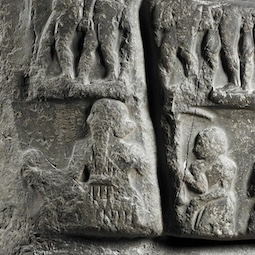The Legend of Sargon and Ur-Zababa
The city of Kish is closely tied to the legends around Sargon, king of Agade, one of the most famous rulers of ancient Iraq (Figure 1). Sargon supposedly began his political career as a cup-bearer at Kish for king Ur-Zababa, defeated the king of Uruk, Lugal-zage-si, and founded an impressively large empire which extended over Iraq, Iran, Syria, Turkey, and stretched up to the Mediterranean in the west and the Indus Valley in the east.
 [/kish/images/map-of-iraq-large.jpg]
[/kish/images/map-of-iraq-large.jpg]1. This badly damaged diorite monument depicts Sargon of Akkad (identified by a badly damaged inscription in front of his face). He leads a retinue of senior officials. Above him, naked captives are led away. The opposite side of the monument shows a battle, with vultures coming to feast on the dead. It was probably carved in Nippur during Sargon's reign, c. 2300 BC, but was captured and transported to Susa in southwest Iran, a thousand years later, by the Elamite king Shutruk-Nahhunte I. Source: Sb 1, Louvre Museum [https://collections.louvre.fr/en/ark:/53355/cl010123451].
In the legend "Sargon and Ur-Zababa", king Ur-Zababa is overtaken by dreams in which he sees he will lose power. Blaming Sargon, Ur-Zababa plots to have him murdered, but every attempt fails thanks to the protection of the goddess Inanna.
"Sargon and Ur-Zababa" has been tentatively reconstructed from two Old Babylonian manuscripts: a fragment from Uruk (Segments A and C) and a more complete tablet from Nippur (Segment B). Both Ur-Zababa, king of Kish, and his usurper Sargon are well-attested historical figures who really did live, but this narrative is not a factual account. Instead, from the perspective of some 500 years after the events it recounts, it uses folktale motifs, and dreams while foretelling the future, to create an image of an honest, humble man (Sargon, literally "true king") who overcomes a deceitful despot (Ur-Zababa) and finds himself king in his place.
Segment A describes how Kish has been restored to splendour under its king Ur-Zababa, but how the two chief deities, An and Enlil, have decided to bring its splendour to an end. Then Sargon himself is mentioned in a fragmentary context. These lines belong to the tradition in Sumerian literature which interprets political events in terms of divine intervention, in the same manner as the Sumerian King List.
Segment B develops the relationship between Ur-Zababa, who has an ill-omened dream which he refuses to discuss, and Sargon, who is appointed to be his cup-bearer, an important post in the royal household. Some days later, Ur-Zababa has a trembling reaction to his dream: "Like a lion he urinated, sprinkling his legs". A further dream then comes to Sargon which, to his horror, confirms that Ur-Zababa has reason to tremble. As Sargon recounts to the king, in his dream the goddess Inana, the patron deity of Kish, drowned Ur-Zababa in "a river of blood".
Ur-Zababa distorts the contents of Sargon's dream, claiming that it is Sargon instead who is doomed, and instructs his chief smith to fulfill the distorted dream in melodramatic fashion, by disposing of the cupbearer in the type of mould used for casting statues. However, the goddess Inanna, who supports Sargon rather than Ur-Zababa, saves the cup-bearer by advising him not to enter the fated temple because he is polluted with blood, presumably as a consequence of his own dream. Sargon's survival fills Ur-Zababa with further foreboding and he devises another plot against the cup-bearer. He sends him to the ruler of Uruk, Lugal-zage-si, with a message instructing that its bearer be killed. Thus an additional folklore motif is incorporated within the ideological narrative, another bearer of such a message being the ancient Greek hero Bellerophon in the Iliad.
The contents of Segment C, set not in Kish but in Uruk, whose patron deity was also Inana, remain unclear. They do, however, indicate the continued survival of Sargon. The historical evidence also supports his survival: he became king of Kish, giving him control of the north of Babylonia; defeated Lugal-zage-si, giving him control of much of the south; and founded his own capital city, Agade, whose patron deity was again Inanna.
- Read an English translation of "Sargon and Ur-Zababa" [https://etcsl.orinst.ox.ac.uk/cgi-bin/etcsl.cgi?text=t.2.1.4#] on the Electronic Text Corpus of Sumerian Literature (ETCSL 2.1.4)
20 Oct 2025
Nadia Aït Saïd-Ghanem & Eleanor Robson
Nadia Aït Saïd-Ghanem & Eleanor Robson, 'The Legend of Sargon and Ur-Zababa', The Forgotten City of Kish • مدينة كيش المنسية, The Kish Project, 2025 [http://oracc.org/KingsandLegends/SargonandUr-Zababa/]